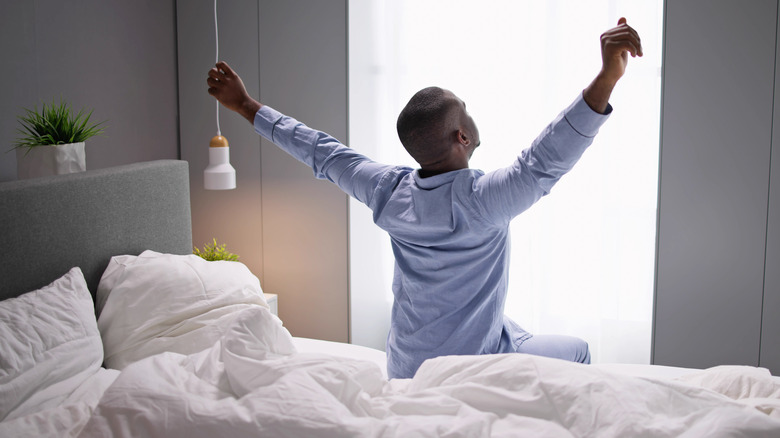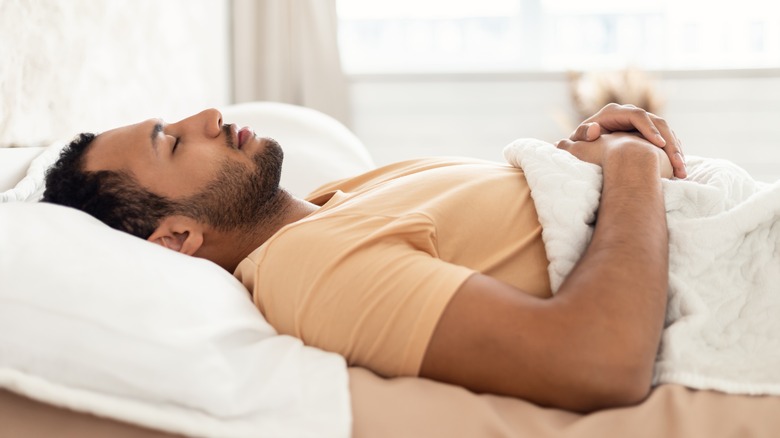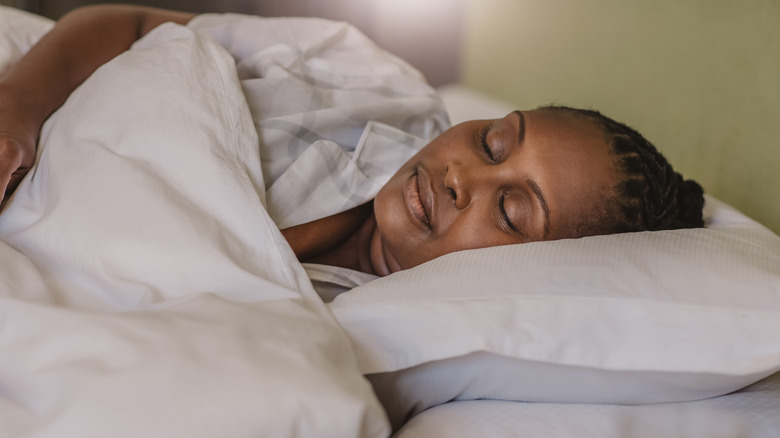Avoid This Sleep Position If You Have High Blood Pressure And Sleep Apnea
According to the U.S. Centers for Disease Control and Prevention (CDC), survey data from 2017 to 2018 showed that prevalence rates for hypertension (high blood pressure) among adults stood at over 45%. Additionally, researchers from a 2023 study published in Cureus pointed out how about 50% to 60% of people with obstructive sleep apnea also have daytime hypertension, with over 30% of patients with high blood pressure having been found to have OSA. Obstructive sleep apnea is also thought to play a role in cases of drug-resistant hypertension.
While there is some debate among the medical community regarding which sleeping position may be safest for people with high blood pressure and sleep apnea, there's one position that seems best avoided altogether. For these individuals, sleeping on their back at night may increase the risk for certain cardiovascular conditions, according to the American Heart Association (AHA).
An AHA press release outlined research findings presented at the 2023 Hypertension Scientific Sessions conference from a longitudinal study involving over 11,000 adults from both urban and rural regions of the U.S. The research showed that people who had high blood pressure readings while lying flat on their back (supine position), as well as when sitting up straight, were more susceptible to stroke, heart disease, heart failure, or early death compared to adults who did not have high blood pressure when in both positions. Even for patients who did not have high blood pressure readings when sitting upright — but did have high blood pressure when lying supine — these individuals still had approximately the same increased risk for the outlined health conditions as adults who had high blood pressure while in both positions.
Sleep apnea, high blood pressure, and back sleeping
Obstructive sleep apnea and high blood pressure are two conditions that appear to go hand in hand. It has been reported that 89% of people between the ages of 18-35 with high blood pressure not due to secondary causes have obstructive sleep apnea (OSA) as an underlying condition, according to a 2022 study in Current Hypertension Reports.
Experts at Sleep Centers of Middle Tennessee explain that because a person with OSA is getting less oxygen due to airway blockages while they sleep, the heart has to work overtime to get oxygen-rich blood circulated throughout the body. As the heart pumps more blood, our blood pressure rises with the increase of pressure on artery walls. For this reason, people with obstructive sleep apnea are advised to avoid the supine position, which can exacerbate symptoms of OSA and subsequently boost blood pressure (per HealthMatch).
If you have high blood pressure and sleep apnea, sleep on your left side
Because there is no single right answer for which sleeping position is optimal for people with high blood pressure and sleep apnea, it's best to talk with your healthcare provider. However, side sleeping minimizes the chances of airway obstruction in sleep apnea (per Florida Dental Sleep Disorders). Additionally, when it comes to high blood pressure, some experts feel that sleeping on one's left side may be the safest option.
The reason is that blood flow circulates back to the heart, entering on the right side. Sleeping on our right side may therefore run the risk of compressing the blood vessels that flow back to the heart and subsequently hinder circulation (per HealthMatch). Depending on what's right for you, your doctor may suggest left-side sleeping as opposed to spending the night in the supine position.
If you're someone who experiences nighttime increases in blood pressure (called nocturnal hypertension), taking any prescribed blood pressure medications before bed, maintaining a regular early sleep schedule, and abstaining from alcohol or coffee in the evenings are all measures that can help regulate blood pressure while you snooze.


